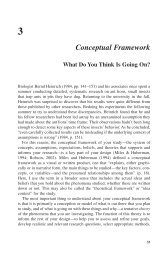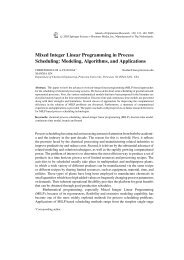R7.1 Polymerization
R7.1 Polymerization
R7.1 Polymerization
Create successful ePaper yourself
Turn your PDF publications into a flip-book with our unique Google optimized e-Paper software.
377<br />
Chap.<br />
chains form. First, we neglect the termination terms ( ktSSRj<br />
and ktmRj<br />
M)<br />
with<br />
respect to propagation terms in the mole balances. This assumption is an excellent<br />
one as long as the monomer concentration remains greater than the live<br />
polymer concentration.<br />
For this point, we can make several assumptions. We could assume that<br />
the initiator ( I � A�)<br />
reacts slowly to form R1<br />
(such is the case in Problem<br />
).<br />
CDP7-P<br />
B<br />
0<br />
I� M ⎯⎯→ R 1<br />
dR1 Initiation<br />
-------- � k0 MI � kp R<br />
dt<br />
1M<br />
Another assumption is that the rate of formation of R1<br />
from the initiator is<br />
instantaneous and that at time t � 0 the initial concentration of live polymer is<br />
R10 � I0. This assumption is very reasonable for this initiation mechanism.<br />
Under the latter assumption the mole balances become<br />
Propagation<br />
dR1 -------- � �k<br />
p MR1 dt<br />
(<strong>R7.1</strong>-38)<br />
dR2 -------- � k p MR ( 1�R2) dt<br />
(<strong>R7.1</strong>-39)<br />
…<br />
dRj -------- � k p ( R j� 1�R<br />
j)M<br />
(<strong>R7.1</strong>-40)<br />
dt<br />
For the live polymer with the largest chain length that will exist, the mole balance<br />
is<br />
dRn -------- � k p MRn� 1<br />
dt<br />
If we sum Equations (R7-1.38) through (R7-1.41), we find that<br />
dRj<br />
dt<br />
--------<br />
n<br />
� dR�<br />
� -------- �0<br />
dt<br />
j � 1<br />
(<strong>R7.1</strong>-41)<br />
Consequently, we see the total free live polymer concentration is a constant at<br />
R * � R 10 � I 0.<br />
There are a number of different techniques that can be used to solve this<br />
set of equations, such as use of Laplace transforms, generating functions, statistical<br />
methods, and numerical and analytical techniques. We can obtain an<br />
analytical solution by using the following transformation. Let<br />
k<br />
d� �<br />
k p M dt<br />
(<strong>R7.1</strong>-42)
















